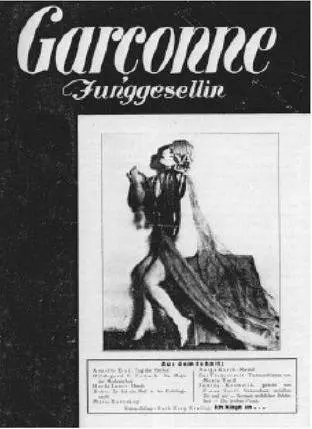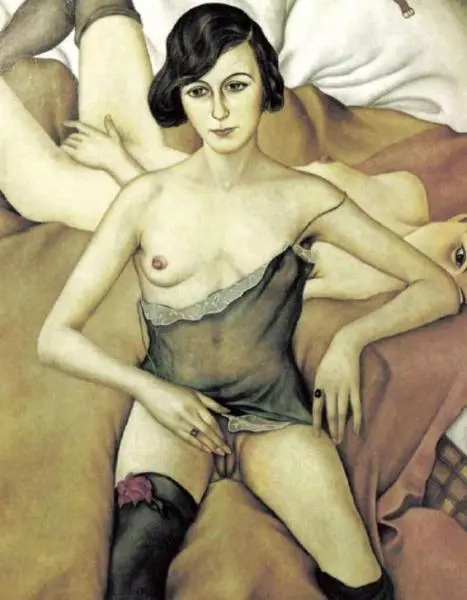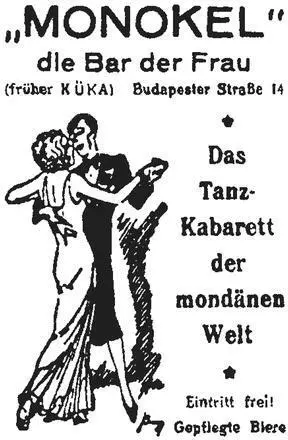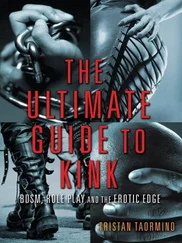LESBIAN SOCIAL CLUBS
“CLUB MONBIJOU OF THE WEST”—An organization of six hundred Garçonnes . Its headquarters was MALI AND INGEL, which they attended on weekdays. [For one-year the Monbijou Westies met at the HOHENZOLLERN LOUNGE.] Only chi-chi fashion-conscious Garçonnes were eligible for membership status. Tickets for the Monbijou West’s two annual winter balls at the Scala Variety theatre were said to be the most sought-after items on the Berlin lesbian social calendar.
“CLUB OF THE GIRL-FRIENDS”—Small auxiliary lesbian faction of “Association of Human Rights,” the powerful male homosexual Berlin organization. “Girl-Friends” coordinated many cultural projects, including lesbian sporting activities, outdoor health weekends, Sunday book-club readings, informative lectures, and a score of private educational classes. Its members contributed to the influential gay newspaper, Blätter für Menschenrecht . Less successful were its social events and winter-time celebrations.
Divided into two sections, a “Southwest” club, which held Wednesday dances at the ZAUBERFLÖTE, and a sister “Northeast” unit that met at the ALEXANDER-PALAST and KÖHLER’S DANCE HALL twice a week. Partly because of their over-developed intellectual nature, Girl-Friends ’ planning of costume parties suffered from vastly overhyped advertising, weak leadership, and a general “North German” stiffness. Highpoint of the balls was always the Tyrolian “Choo-Choo” dance, in which the dancers assembled in a long line, and the “Wash Waltz,” where participants mimed scrubbing down their partners with imaginary brushes.
“LADIES CLUB ERATO”—An exclusive Jewish club of Gamines , which met on Monday afternoon at the ZAUBERFLÖTE. It was also an affiliate of the “Association of Human Rights.” At their annual September ball and dinner, the “Ladies’ Pearl Festival,” each Erato member received a pearl-necklace. Headed by feminist writer Selli Engler, the editor of the monthly BIF , the Journal of Ideal Female Friendship.
“LADIES CLUB MONBIJOU”—A member of the “German Friendship Association,” the Monbijou encouraged Garçonne cultural activity, especially the reading of private poetry and contemporary erotic literature. Met weekly at the CAFÉ DORIAN GRAY and was long associated with the lesbian news publications Frauenliebe (after 1928 called Garçonne ) and Neue Freundschaft .
“LADIES CLUB PYRAMID”—A loosely-organized society of Garçonnes , the Pyramid officials created exciting social gatherings every Monday evening at the TOPPKELLER but without the heterosexual prostitutes, men, and other gawkers. Ongoing lovers’ quarrels, especially those between club members who were working-class Garçonnes and artistic types (including actresses from Erwin Piscator’s theatre collective) erupted through the night and were generally settled in the Topp courtyard with “heartfelt apologies, tender embraces, and impassioned kissing.”
“LADIES CLUB SCORPION”—Organized by the charming Bubi-meister Walterchen, the Scorpion held relatively sedate dances at the downbeat TAVERNE on Thursday, Saturday, and Sunday evenings. Thought to be named after the bestselling German lesbian novel, The Scorpion by Anna Weinauch, the prewar generic name for lesbian temptresses, or Walterchen’s astrological sign. (Or all three.) A place for not so elegant Bubis and Mädis .
“LADIES CLUB VIOLETTA”—A militant lesbian organization of 400 working-class women, female transvestites, and their supporters. Established by super- Bubi Lotte Hahn, a legendary fighter for lesbian legal rights, the Violetta contemptuously looked down its nose at the social rostrum of more insular associations. It was critical of the emphasis on physical appearance (“Sex-Appeal”) and the cult of stardom that many Berlin lesbian clubs consciously promoted. To counter that exclusionary world view, Hahn threw frequent Sunday picnics in the Tiergarten and organized “beach party” outings in the summer. Violetta also supported a feminist Body Culture regimen for indoor workers. More than any other Berlin society, the Violetta dealt with the problems and needs of full-time female transvestites.
Heavily advertised as an ideal meeting-place for lesbian singles, the Violetta organized its own dances three times a week at the RHEINISCHER HOF, MANUELA, NATIONHOF, or ZAUBERFLÖTE halls. Particularly well received were its “Sailor Parties,” “Transvestite Parties” (cross-dressing was mandatory for admittance), and “Fun Evenings,” where each Violetta member had to fill out a card indicating her wildest sexual fantasy. The violet and the popular lesbian “Lilac Song” were the club’s emblem and signature theme. Always championed in the oldest German lesbian newspaper, Die Freundin , a biweekly much respected in straight leftist circles.
ʺSOCIETY CLUB LAMETIERʺ—A little-talked about organization of Sharpers , Lametier members met socially at the SCHUBERT HALL in Berlin West on Sunday evenings.

Also a vitalistic philosophy of lesbian superiority animated both the separatist and apolitical associations. Ruth Roellig, a highly regarded journalist and colleague of Hirschfeld, wrote in 1929, “Lesbian love arises from the refinement and depth of emotional experience where all the forces of body and soul become fused, and then unfolded. Not to perform sexually when God has blessed one with an ideal love-soul would be to deprive oneself and others of a great pleasure. Among lesbians, there may exist love affinities which no longer vacillate desperately between angel and brute, but in a love that is sacred, pure, and beautiful in itself.”


Artistic types, like the lesbian Body Culture enthusiasts Hedwig Hagemann and Dora Menzler, claimed that women’s sexuality was much more complicated and dense with erotic possibilities than that of men; therefore, at their semi-mystical demonstrations of young naked female dancers, male spectators, with very rare exceptions, were prohibited. Although there was some tactical individual empathy with gay men and male transvestites, most lesbians in Berlin lived in a utopic environment separate from and independent of men.
Like other Berliners, lesbians were internationally esteemed for their unusual nightlife. “Married” or single, the Girl-Friends played out their vivacious lifestyle in seemingly promiscuous capers and taunting public displays of affection. Sexy personal columns and highly detailed stories of brief romantic affairs were the basic fillers of all lesbian publications. And nearly every lesbian organization, especially ones with serious political agendas, advertised late-night, hard-drinking weekly parties and exclusive masked balls from late December to February.
These spirited affairs were restricted to dues-paying members, but a half-dozen lesbian clubs also welcomed a curious tourist trade. In fact, the English Cook Travel Agency featured such tours after 1928. Precisely at midnight, special coach buses picked up kinky sightseers at each of the major Berlin hotels and delivered them to the “Toppkeller” and other late-night sapphic emporiums in the Berlin West, near Bülowstrasse. For straight British couples, in particular, these anthropological excursions were the memorable high point of their Continental revelry.
Читать дальше















